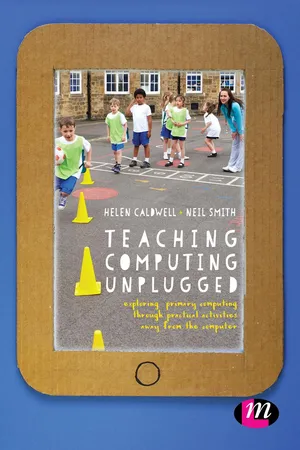
Teaching Computing Unplugged in Primary Schools
Exploring primary computing through practical activities away from the computer
- 216 pages
- English
- ePUB (mobile friendly)
- Available on iOS & Android
Teaching Computing Unplugged in Primary Schools
Exploring primary computing through practical activities away from the computer
About This Book
Teaching primary computing without computers? The Computing curriculum is a challenge for primary school teachers. The realities of primary school resources mean limited access to computer hardware. But computing is about more than computers. Important aspects of the fundamental principles and concepts of computer science can be taught without any hardware. Children can learn to analyse problems and computational terms and apply computational thinking to solve problems without turning on a computer.
This book shows youhow you can teach computing through 'unplugged' activities. It provides lesson examples and everyday activities to help teachers and pupils explore computing concepts in a concrete way, accelerating their understanding and grasp of key ideas such as abstraction, logic, algorithms and data representation. The unplugged approach is physical and collaborative, using kinaesthetic learning to help make computing concepts more meaningful and memorable. This book will help you to elevate your teaching, and your children?s learning of computing beyond the available hardware. It focuses on the building blocks of understanding required for computation thinking.
Frequently asked questions
Information
Chapter 1 Robots
Introduction
Learning Outcomes
- specify the operations that can be used to perform a task and assemble them into an algorithm
- design and lead a computing unplugged activity for your class that helps children to understand that programmers need to write precise sequences of instructions;
- identify and build upon children's natural use of computing concepts such as loops and decision making in the context of programming human robots.
Links to Teachers’ Standards
- TS2d Demonstrate knowledge and understanding of how pupils learn.
- TS2e Encourage pupils to take a responsible and conscientious attitude to their own work.
- TS3a Have a secure knowledge of the relevant subject(s) and curriculum areas, foster and maintain pupils’ interest in the subject.
- TS4a Promote a love of learning and children's intellectual curiosity.
- TS4e Contribute to the design and provision of an engaging curriculum.
Links to National Curriculum Programmes of Study
- Understand what algorithms are, how they are implemented as programs on digital devices, and that programs execute by following precise and unambiguous instructions.
- Create and debug simple programs.
- Use logical reasoning to predict the behaviour of simple programs.
- Design, write and debug programs that accomplish specific goals, including controlling or simulating physical systems; solve problems by decomposing them into smaller parts.
- Use sequence, selection, and repetition in programs; work with variables and various forms of input and output.
- Use logical reasoning to explain how some simple algorithms work and to detect and correct errors in algorithms and programs.
Need to Know
Table of contents
- Cover
- Half Title
- Publisher Note
- Title Page
- Copyright Page
- Contents
- About the Authors and Contributors
- Acknowledgements
- Introduction: Computing Unplugged
- Chapter 1 Robots
- Chapter 2 Musicians
- Chapter 3 Artists
- Chapter 4 Explorers
- Chapter 5 Code Breakers: Dpef Csfblfst
- Chapter 6 Magicians
- Chapter 7 Gamers
- Chapter 8 Cooks
- Chapter 9 Scientists
- Index